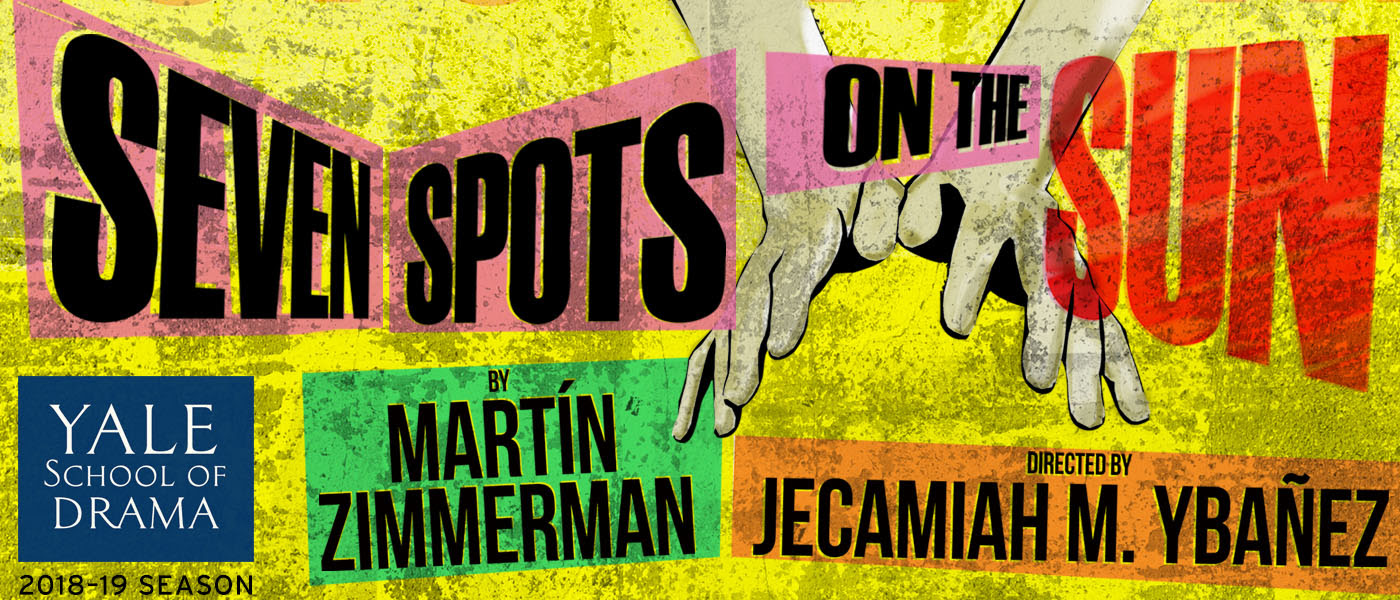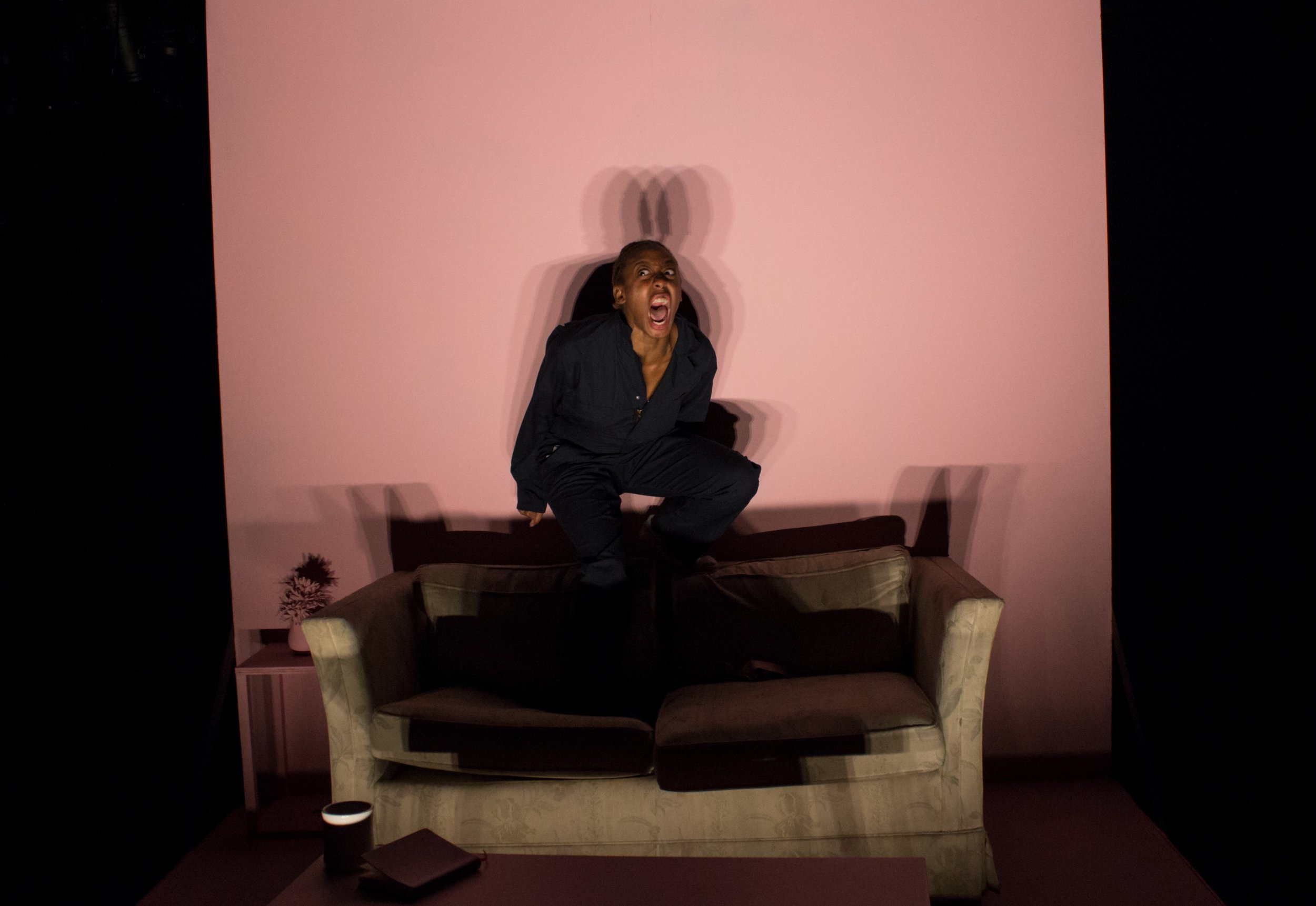Review of Seven Spots on the Sun, Yale School of Drama
As this gripping play goes on, Seven Spots on the Sun by Martín Zimmerman, directed by third-year Yale School of Drama directing student Jecamiah M. Ybañez, becomes an instance of folk history, one that derives its force from traumatic events. Designated as “The Town,” figures in a collective ensemble (Brandon E. Burton, Louisa Jacobson, Kineta Kunutu, JJ McGlone, Ilia Isorelýs Paulino, Jakeem Powell) voice a kind of stricken amazement at events that seem the stuff of legend. Zimmerman’s play, in treating the depredations of a civil war, its aftermath, and the effects of a general amnesty for war crimes, has its eye on the tragic course of more than one Latin American country, while the play’s manner lends itself to fable and the sort of retribution we may think of as Fate.
Early on we learn that the town, which is overjoyed when radio transmissions recommence, accords special status to Moisés (Dario Ladani Sánchez), a former medic who has suffered more than most. So when he smashes the radio so as not to hear pronouncements about the newly instituted government, no one confronts him. The story of all he lost is told in parallel with the story of Mónica (Adrienne Wells), who speaks to the audience about her love for Luis (Robert Lee Hart), a miner in Ojona, who becomes a soldier because he expects it will provide more stability and an eventual pension. Wells’ straightforward address does much to give us direct access to life within the town.
Then the civil war comes, creating a horribly fraught world where victims of soldiers can be left to die in San Isidro’s town square while the town, frightened off by the hand-prints in white paint left as a warning, must endure the misery in their midst. As Belén, Moisés’ beloved, Sohina Sidhu’s emotional reaction to the cries of the dying boy (Powell) provides an important crux for the events to come. Whereas most of us have to read or watch news reports to be reminded, in the midst of our comfortable lives, that horrors are occurring elsewhere, Belén is unable to enjoy the mangoes that Moisés traded morphine for. Finally, goaded by her distress, Moisés agrees to take the boy into the clinic.
When soldiers are reported to be coming back to town, it’s understood that whoever has helped the boy will die. Moisés, despite his overt contempt for the cowardly priest Eugenio (José Espinosa), tries to find sanctuary in the church. Eugenio’s narration of what happens then is delivered by Espinosa as a shameful failure but also as if events are beyond his control—a feeling that gains conviction in the second part of the play. Meanwhile, Luis eventually returns from the war to his wife and newborn son, but he’s no longer the man his wife loved and she fears him.
The full details of the punishment visited upon Moisés are not revealed until late. In the play’s present, we see how, despite Moisés’ antipathy, Eugenio must come to him with a plea: there is a plague in the area that is besetting the children, its symptoms painful but sweet-smelling boils that cause death. Moisés reluctantly agrees to examine a child, then withdraws, appalled by his lack of ability and his own indifference. Eugenio comes again to tell him of a miracle: the child was immediately healed.
The parallel course of the play means that we shouldn’t be surprised that the child of Luis and Mónica will need to be healed by Moisés, but when we learn the part that Luis played in what became of Belén, the play creates a situation worthy of Solomon. At the heart of the dramatic situation is the question of atonement and forgiveness, and how wounds to the social body cannot be healed any other way, though it is more typical to expect that whoever has the upper-hand will exact whatever price satisfies the lust for revenge.
The deftness of the play’s plot is much to its advantage. This is not a realistic tale that strains credulity, but rather a fable about war and love, about hatred and desperate need. The four main characters have both a genuine specificity and a generic quality. The male roles are difficult due to the extremes the actors must evince. Hart’s Luis seems an aloof lover who does what he wants and expects his wife to accept his view; his eventual transformation seems not to take as much toll on him as it might. Sánchez’s Moisés is quite effective in his despair, but perhaps less so in his ultimatums. We have to believe in these characters as persons caught up in events beyond their control and then see them as figures of ultimate nemesis. It’s a striking situation, and an admirable effort.
The boxlike set makes the town seem a cell, an interesting comment on how all are imprisoned by past events they can’t overcome. Late in the play, a wall falls as if breaking through a façade and into the dark events that keep the town spellbound. The fascinating ensemble, with expressive choreography by Jake Ryan Lozano, creates the manner of a people struck to the heart by the story it must tell for the sake of its souls, the individual members wearing haunted looks that stay with us beyond the wrenching outcome.
Grim and trying, Seven Spots on the Sun’s sense of humanity is not without redemption, though it firmly presents the horrors of history as a curse upon the present.
Seven Spots on the Sun
By Martín Zimmerman
Directed by Jecamiah M. Ybañez
Choreographer: Jake Ryan Lozano; Scenic Designer: Lily Guerin; Lighting Designer: Evan Christian Anderson; Costume Designer: April M. Hickman; Sound Designer and Composer: Andrew Rovner; Projection and Video Designer: Christopher Evans; Production Dramaturg: Evan Hill; Technical Director: Jenna Heo; Stage Manager: Zachry J. Bailey
Cast: Brandon E. Burton, José Espinosa, Robert Lee Hart, Louisa Jacobson, Kineta Kunutu, JJ McGlone, Ilia Isorelýs Paulino, Jakeem Powell, Dario Ladani Sánchez, Sohina Sidhu, Adrienne Wells
Yale School of Drama
December 13-18, 2018











